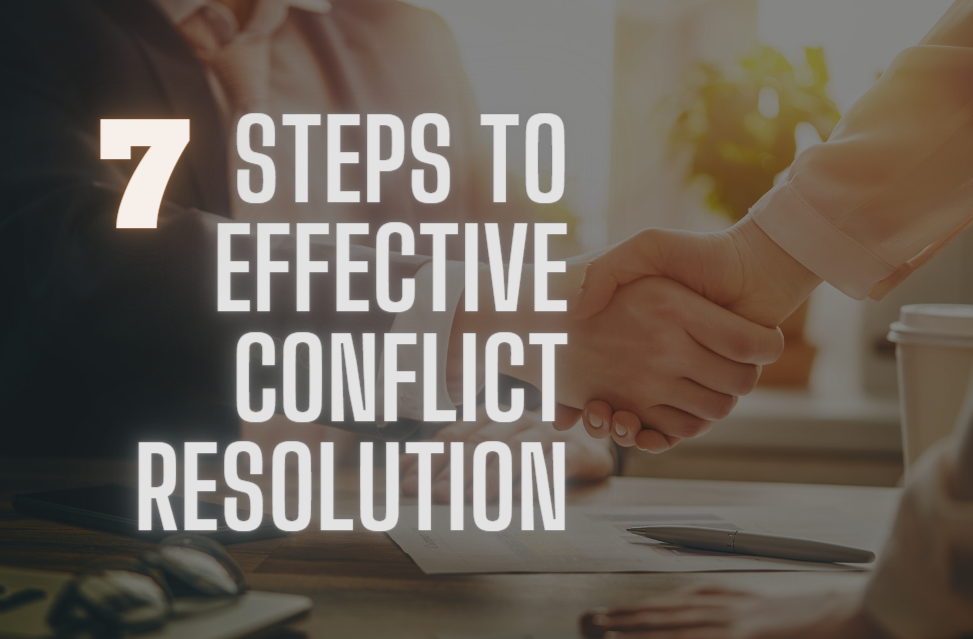Introduction
You’re no stranger to disagreements, right? They’re a part of life. But what if you could handle them better, both at home and work? We’ve got 7 steps that’ll turn you into a pro at resolving conflicts.
1. It’s all about understanding, communicating, and listening. These three elements are crucial in any conflict resolution process. By understanding the other person’s perspective, effectively communicating your own thoughts and feelings, and actively listening to each other, you can lay a solid foundation for resolving the disagreement.
2. Acknowledging emotions is another vital step. Conflict often stirs up strong emotions, and acknowledging and validating these emotions can help create a safe space for open and honest discussions.
3. Finding common goals is the next step. Identifying shared objectives or interests can help shift the focus from individual needs to collaborative problem-solving. By working towards a common goal, you can foster cooperation and teamwork.
4. Exploring solutions is an important part of conflict resolution. Brainstorming and considering various options can lead to creative and mutually beneficial solutions that meet the needs of all parties involved.
5. Once you’ve explored different solutions, it’s time to implement them. Taking action and putting the agreed-upon solutions into practice is crucial for resolving the conflict and moving forward.
Ready? Let’s dive in.
Understanding the Nature of Conflict
Why do conflicts arise in your personal and work life, and what exactly fuels their existence?
It’s all about differences. You’re unique and so is the person next to you. This means that your perspectives, beliefs, values, and ways of handling situations won’t always align. When you’re unable or unwilling to acknowledge these differences, conflict erupts. You may feel misunderstood or undervalued, leading to frustration or anger.
In the workplace, this can stem from competition, scarce resources, or misunderstandings. At home, it might be due to unmet expectations or communication breakdowns. Understanding this is the first step to managing conflicts.
Recognize that it’s okay to disagree but it’s how you handle these disagreements that’ll determine the outcome.
Emphasizing Effective Communication
To effectively resolve conflicts, you’ve got to ramp up your communication skills, ensuring you express your thoughts clearly and listen attentively to the other party’s perspective. It’s not just about talking, it’s about meaningful conversations where both parties feel heard.
Use ‘I’ statements to express feelings without blaming. For instance, instead of saying ‘You make me feel ignored,’ say, ‘I feel ignored when I speak.’ This reduces defensiveness and opens the door for dialogue.
Pay attention to non-verbal cues, they’re just as important. Nodding, maintaining eye contact, and adopting an open posture show you’re interested and engaged.
Practicing Active Listening
In your quest for effective conflict resolution, it’s crucial to hone your active listening skills. This isn’t just about hearing words; it’s about understanding the message behind them.
Here’s how you can do it.
First, focus entirely on the speaker. Don’t let your mind wander.
Second, avoid interrupting. People appreciate when they’re allowed to express their thoughts fully.
Third, give feedback. Paraphrase what’s been said to ensure you’ve got it right.
Finally, respond appropriately. This shows respect for the speaker’s thoughts and feelings.
Acknowledging and Validating Emotions
After mastering active listening, the next step in navigating conflict effectively, both in your personal and work life, involves acknowledging and validating the emotions of others.
You can’t ignore the feelings involved in conflict. They’re a significant part of the issue and require your attention.
Acknowledging means you recognize the feelings that others express, even if you don’t agree with them. Validation is taking it a step further. It’s about expressing that their feelings make sense, showing empathy.
You don’t have to agree with their perspective, but you must understand why they feel the way they do. This approach reduces defensiveness, fosters understanding, and paves the way for a resolution.
Identifying Common Goals
Moving forward from acknowledging and validating emotions, it’s essential for you to identify common goals amidst the heat of the conflict. This step helps you to refocus on what you’re both trying to achieve, rather than getting lost in the whirlwind of disagreement.
Common goals can be as simple as wanting to maintain a healthy relationship or as complex as completing a project successfully. It’s crucial to find these shared objectives, as they become the bridge that connects opposing viewpoints.
Once identified, you can start to align your strategies and approach. This doesn’t mean you’ll always agree, but it does mean you’re both pulling in the same direction.
Exploring Possible Solutions
Once you’ve aligned your strategies towards shared objectives, it’s time to delve into the heart of conflict resolution by exploring possible solutions. Remember, this isn’t about winning or losing. Instead, focus on finding a resolution that everyone can agree on.
Start by brainstorming potential solutions. Be open-minded and consider all ideas, no matter how outlandish they may seem. It’s about finding common ground, not imposing your will.
Then, evaluate these options carefully. Consider the pros and cons of each solution, and gauge their feasibility. Don’t rush this process; take the time to think things through.
Lastly, negotiate fairly. Be prepared to make compromises. This way, you’re not only resolving the conflict, you’re also building stronger relationships.
Implementing and Monitoring Resolution
With your negotiated solution in hand, it’s now time for you to step into the crucial stage of implementing and monitoring the resolution. Don’t just assume things will naturally fall into place. Instead, take charge, ensuring every party involved understands their roles and responsibilities. If it’s a workplace dispute, you may need to involve HR or management for enforcement.
Then comes monitoring. This isn’t a one-off event but a continuous process. Keep checking in to ensure all parties are sticking to the agreed-upon resolution. If you notice any deviation, don’t hesitate to address it immediately.
Conclusion
Understanding conflict, communicating effectively, and actively listening are key steps in managing disputes.
Acknowledging emotions, identifying common goals, exploring solutions, and implementing resolutions are also important skills to master.
By mastering these skills, you’ll be better equipped to navigate disagreements, both in your personal and work life.
Remember, conflict isn’t always negative. It’s your approach that makes the difference.
So, keep practicing, stay patient, and watch your relationships grow stronger.





